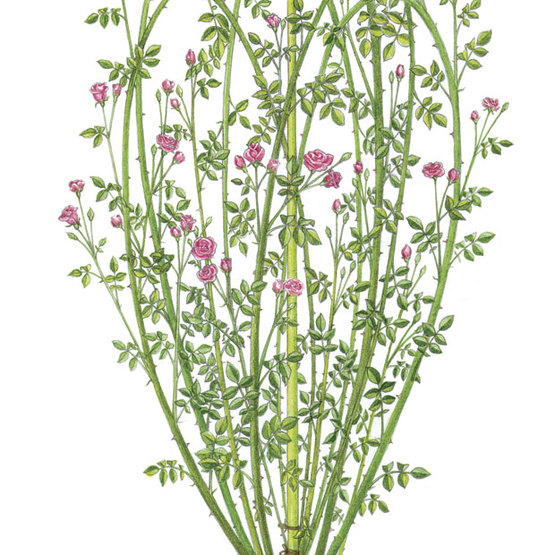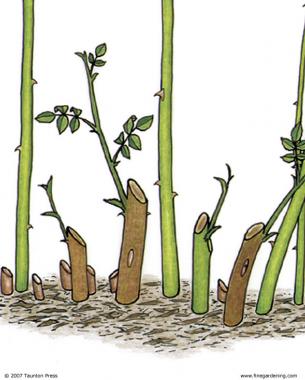
Gardeners often say they don’t plant climbing roses or large shrub roses because they’re difficult to keep under control and they take up too much space, especially if the garden is small. This may be true, but the problem is easily solved. Simply arching a rambler’s long canes confines and controls them and produces more blooms at the same time. The technique is called self-pegging.
To understand this technique and why it works, it is helpful first to know a little bit about a climbing rose’s physiology. Even though they are commonly called climbing roses, climbers are really just large shrubs. Truly climbing plants have runners or viny structures that reach out to latch onto anything around them. Unlike wisteria, which winds itself around a support, sweet peas, which grasp with tendrils, or ivy, which has specialized root structures for attachment to surrounding supports, roses do not attach themselves to anything on their own. To clamber upwards and reach sunlight, roses that climb simply take advantage of their thorns’ natural propensity to hook onto anything around them. Furthermore, large shrub roses tend to produce flowers only at the growing tips of their long canes. Each new rose that forms at the apical tips of the canes produces growth inhibitors that prevent competing flowers from being produced lower down their canes. Fewer flowers means less competition for scarce resources of energy and nutrients, which allows a shrub to produce enough seed for next year as well as energy for the next season’s growth.
One way to subvert this physiological fact is to arch the long canes of climbing roses over and secure, or peg, them at the base of the plant. This bending uses gravity to trap the flower-inhibiting hormones at the tips and forces more flower production along the canes. By employing this gardening trick, every bud eye at every leaf node along an arched cane can produce a stem and a flower cluster. Instead of one or two clusters of roses at the end of a single 10-foot cane, a gardener in the know can have upwards of 20 or 30 clusters on that same cane once it is arched over. Just imagine a large shrub rose trained to have 8 to 10 such long arches.
Once you get into the swing of things, self-pegging is a simple procedure. In fact, many gardeners have used this technique in modified ways without realizing it when training climbing roses. Self-pegging controls shrubs that would otherwise overpower your garden, and you get better flower production to boot. What more can a gardener ask?
Three steps for self-pegging
Self-pegging works best on reblooming shrub roses with long, supple canes that will bend without breaking. The technique is best done during the normal pruning time for your area. For example, mild zones like California’s, that time is generally January to mid-February. In the colder zones, the best time to self-peg is generally from April through mid-May, before new growth starts.
1. Prune the canes, preserving several of the most vigorous.

First, prune out any weak or wiry growth from your shrub rose and remove most of the previous year’s leaves so you can see what you are doing.

Then, select four to six of the most vigorous canes and earmark those for self-pegging. In addition, select a few mid-range canes that will function as fill-in canes. Once you’ve selected the best canes, prune out the remaining ones at the base of the shrub.
2. Bend the selected canes and tie them to the base of the shrub.

The best canes for self-pegging measure 8 to 10 feet long. If the canes you’ve selected are not long enough, let them grow on until they are. The mid-range canes should be 3 to 4 feet long. To self-peg the longest canes, bend them back toward the base of the plant and secure them. It is helpful to place an anchor in the middle of a plant to be pegged—I use wooden stakes, which become hidden once the foliage and flowers grow in.

Use gardeners’ soft plastic stretch tape, either green or clear, to secure the canes in place, tying them so that the growing tip of each cane is within 2 to 3 inches of the base of the plant.

Once a shrub is self-pegged, shorten the mid-range canes to random lengths that measure between one-third to one-half of their original length and tuck them discreetly into the cage formed by the pegged canes. These mid-size canes will produce clusters of flowers within the cage, further expanding the dimensionality of the rose pillar.
3. Later, replace old canes with new


To control the size of your rose pillar, remove one old (anything 3 years or older) pegged cane at pruning time for each new cane produced at the base of the plant in the last year. This pruning also helps promote younger, healthier, free-flowering growth. The objective when pruning is to eventually replace the older canes you have already pegged with newer canes that sprout from the base of the plant. So be mindful when pruning to choose three or four new canes that you want to cultivate as replacements.
Safety tip: Make this a two-person job

For your safety, have another person present when self-pegging roses to help hold and tie the canes. Since rose canes are flexible, they can slip and whip back like a switch and hit you, should you let go while tying. One person wearing gloves can grasp the cane and bend it back while the other person ties it securely to a lower point on its own or another cane or on the anchor.
Recommended roses to self-peg
‘Altissimo,’ red, single, 5-9
‘Cardinal de Richelieu,’ purple, fragrant, 4-9
‘Chianti,’ red, fragrant, 4-9
‘Cornelia,’ cherry pink, fragrant, 5-9
‘Gertrude Jekyll,’ pink, fragrant, 5-9
‘Graham Thomas,’ yellow, 5-9
‘Linda Campbell,’ red, fragrant, 5-9
‘Marchioness of Londonderry,’ white, 5-9
‘Polka,’ apricot, 5-9
Fine Gardening Recommended Products

The Regenerative Landscaper: Design and Build Landscapes That Repair the Environment
Fine Gardening receives a commission for items purchased through links on this site, including Amazon Associates and other affiliate advertising programs.

Fine Gardening receives a commission for items purchased through links on this site, including Amazon Associates and other affiliate advertising programs.

Sun Joe Cordless Telescoping Pole Chain Saw
Fine Gardening receives a commission for items purchased through links on this site, including Amazon Associates and other affiliate advertising programs.


















Comments
Log in or create an account to post a comment.
Sign up Log in